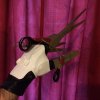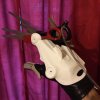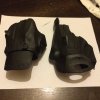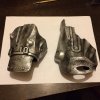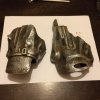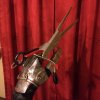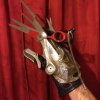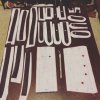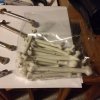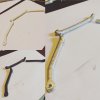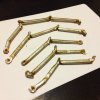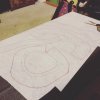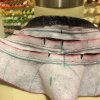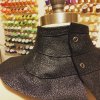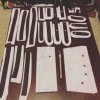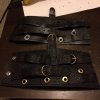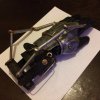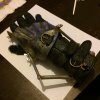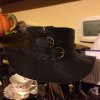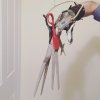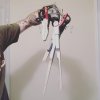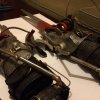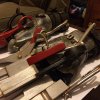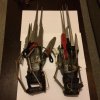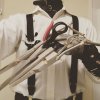Doctor Octoroc
Sr Member
I already finished the prop(s) but I thought I'd post an account of my build process with some photos I took along the way for anyone else interested in building them similarly to my own. If enough interest is generated then I'll consider making the 3d printed parts available on Shapeways for purchase but as of now, this will just be a build thread. Also, to avoid a huge first post, I'll be posting a few steps at a time every day to space it out and allow some feedback or questions along the way as if I was currently building them.
This is a build I did a number of years back but had not gotten into 3d printing yet and was short on time so I used bass wood and craft foam to build them. Here is the original pair next to the new ones - definitely an improvement!

With a bit of weathering, the old pair would have been much better but even so, the materials weren't very durable and by the end of Halloween weekend, I would have had to rebuild the majority of the parts to use them again so I wanted to build a better pair from scratch, hence 3d printing many of the parts. Here are the Solidworks CAD models for the new pair:


Using the same basic shape of the blades from the first build, I recreated the blades first, including the handles (the original build used actual handles that I painstakingly separated from the blades) and all the holes for various found hardware created ahead of time to minimize drilling after the fact.
Here are the raw 3d printed parts for the blades and hand plates:

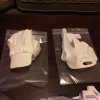
I actually printed the blades a few years ago but just recently decided to move forward with the build. The hand plates I designed and printed more recently, based on the awesome reference material that HMS Mike provided in this thread. I opted for a simpler version of the hand plates as creating them to encase my hands completely would have required multiple test prints to ensure a proper fit while just designing them to fit over top and around the sides allowed for more flexibility during the build and a much easier way to be able to put them on and take them off.
In addition to these 3d printed parts, I used a good deal of found items including a pair of leather gloves (I actually re-used the gloves from my first build so as not to use another pair), large copper paper clips to fashion the buckles, bone party favors from Party City, and a variety of bolts, nuts, wingnuts and washers for securing everything. For the lower leather portions and straps, I used a faux-leather material, brass eyelets, snaps for fastening on the underside and a lot of thread. Luckily, my girlfriend is a fashion major and a costumer at the local theatre so she did the machine work for me and I did the hand-sewing after the fact.
The first step was painting the blades. There are a variety of paints that work on the 3d printed plastics but I've found Testor's enamel model paints to be the best quality, good coverage, and they have a lot of good colors in their library. Every 3d printed part got a base coat of flat black which seeps into the porous material to provide a good base coat of black that won't easily scratch off or reveal the original white color of the plastic with minor sanding.
The below image shows one blade (top) after the black base coat plus a coat of metallic silver and the second blade (bottom) after sanding those two coats. For each blade, I did the following: flat black base coat, metallic silver coat, sanded, metallic silver, sanded, then ended with a different brand (Liquid Leaf) of silver leaf paint I picked up to provide a better metallic look.
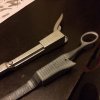
In hind's sight, I wish I had done one or two more coats of the metallic silver and sanding before the silver leaf as some stepping on the 3d printed parts is still visible in the final build. However, after weathering, it's not as noticeable. Below are all of the blades on the left hand before and after weathering. Bottom line is, the more coats with sanding in between, and the better the sanding job, the less those step lines will show. I hand sanded but I really wish I had a Dremel with sanding attachments.
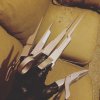
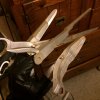
The weathering was done with a combination of wet and dry coats of flat brown Testor's. I used more concentrated amounts in crevices and around the bolts and screws modeled into the 3d printed parts (pretty much anywhere rust would be likely to build) and less concentrated, drier coats across the rest rather randomly. I focused on edges as well to add a bit of definition, as well as any areas where two opposite blades would rub against each other if they were functional scissors, like between the pinky and ring finger, and between the middle and forefinger.
After weathering, I applied red and black gloss Testor's to the appropriate handles. Here are all the blades with their handles painted, and again a detail shot of weathering on the handles, which was basically just the silver leaf paint applied randomly around the edges - thicker on areas that would be likely to wear against things if functional - and anywhere else where other parts of the gauntlets would have likely worn down the edges.
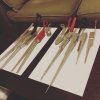
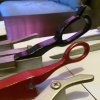
Last up, I sprayed them all down with a few coats of clear coat to protect them from unwanted wear. I probably could have used a better finish as this one dulled the metallic effect but the props aren't exactly shiny and new so some dulling looks fine on them.

And that's it for the blades. Next up, the hand plates!
This is a build I did a number of years back but had not gotten into 3d printing yet and was short on time so I used bass wood and craft foam to build them. Here is the original pair next to the new ones - definitely an improvement!

With a bit of weathering, the old pair would have been much better but even so, the materials weren't very durable and by the end of Halloween weekend, I would have had to rebuild the majority of the parts to use them again so I wanted to build a better pair from scratch, hence 3d printing many of the parts. Here are the Solidworks CAD models for the new pair:


Using the same basic shape of the blades from the first build, I recreated the blades first, including the handles (the original build used actual handles that I painstakingly separated from the blades) and all the holes for various found hardware created ahead of time to minimize drilling after the fact.
Here are the raw 3d printed parts for the blades and hand plates:


I actually printed the blades a few years ago but just recently decided to move forward with the build. The hand plates I designed and printed more recently, based on the awesome reference material that HMS Mike provided in this thread. I opted for a simpler version of the hand plates as creating them to encase my hands completely would have required multiple test prints to ensure a proper fit while just designing them to fit over top and around the sides allowed for more flexibility during the build and a much easier way to be able to put them on and take them off.
In addition to these 3d printed parts, I used a good deal of found items including a pair of leather gloves (I actually re-used the gloves from my first build so as not to use another pair), large copper paper clips to fashion the buckles, bone party favors from Party City, and a variety of bolts, nuts, wingnuts and washers for securing everything. For the lower leather portions and straps, I used a faux-leather material, brass eyelets, snaps for fastening on the underside and a lot of thread. Luckily, my girlfriend is a fashion major and a costumer at the local theatre so she did the machine work for me and I did the hand-sewing after the fact.
The first step was painting the blades. There are a variety of paints that work on the 3d printed plastics but I've found Testor's enamel model paints to be the best quality, good coverage, and they have a lot of good colors in their library. Every 3d printed part got a base coat of flat black which seeps into the porous material to provide a good base coat of black that won't easily scratch off or reveal the original white color of the plastic with minor sanding.
The below image shows one blade (top) after the black base coat plus a coat of metallic silver and the second blade (bottom) after sanding those two coats. For each blade, I did the following: flat black base coat, metallic silver coat, sanded, metallic silver, sanded, then ended with a different brand (Liquid Leaf) of silver leaf paint I picked up to provide a better metallic look.

In hind's sight, I wish I had done one or two more coats of the metallic silver and sanding before the silver leaf as some stepping on the 3d printed parts is still visible in the final build. However, after weathering, it's not as noticeable. Below are all of the blades on the left hand before and after weathering. Bottom line is, the more coats with sanding in between, and the better the sanding job, the less those step lines will show. I hand sanded but I really wish I had a Dremel with sanding attachments.


The weathering was done with a combination of wet and dry coats of flat brown Testor's. I used more concentrated amounts in crevices and around the bolts and screws modeled into the 3d printed parts (pretty much anywhere rust would be likely to build) and less concentrated, drier coats across the rest rather randomly. I focused on edges as well to add a bit of definition, as well as any areas where two opposite blades would rub against each other if they were functional scissors, like between the pinky and ring finger, and between the middle and forefinger.
After weathering, I applied red and black gloss Testor's to the appropriate handles. Here are all the blades with their handles painted, and again a detail shot of weathering on the handles, which was basically just the silver leaf paint applied randomly around the edges - thicker on areas that would be likely to wear against things if functional - and anywhere else where other parts of the gauntlets would have likely worn down the edges.


Last up, I sprayed them all down with a few coats of clear coat to protect them from unwanted wear. I probably could have used a better finish as this one dulled the metallic effect but the props aren't exactly shiny and new so some dulling looks fine on them.

And that's it for the blades. Next up, the hand plates!
Last edited:

